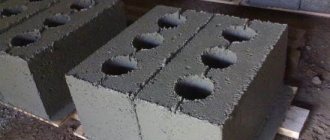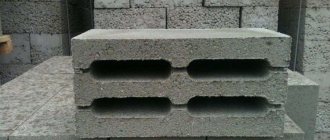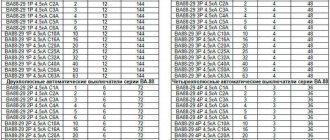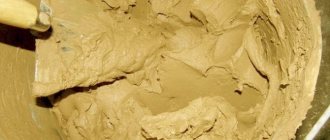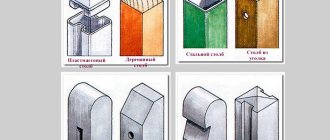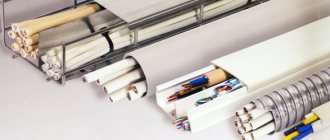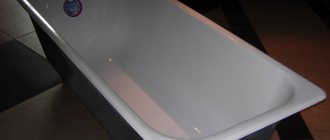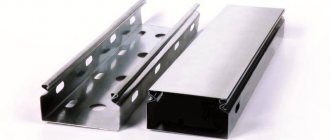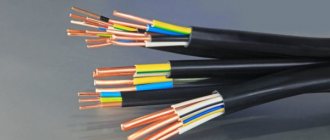Previously, we have already looked at artificial building stones with a cement binder - foam concrete blocks, widely used in modern construction. But this is not the only popular material for the production of building blocks. Cinder concrete blocks are no less often used in construction. Cinder blocks are an artificial stone produced by vibratory pressing from a mixture of cement and crushed blast furnace slag. Sand and gravel mixture, perlite, expanded clay, ash, broken brick, or locally produced waste suitable for physical characteristics can also be used as filler. The resulting building material is lightweight, has excellent thermal characteristics and is easy to process.
Let's look today at what cinder blocks are, find out their characteristics, and also find out how much they cost.
Pros of cinder blocks
The undoubted advantages of cinder blocks include:
- availability of materials for block production;
- low cost;
- high resistance to heat transfer, providing good thermal characteristics of artificial stone;
- sufficient strength for low-rise construction;
- ease of processing;
- light weight, which reduces the cost of building foundations;
- walls made of cinder blocks are not susceptible to being eaten by harmful insects and bacteria, like walls made of wood;
- cinder blocks are fireproof, which plays an important role when choosing materials for the construction of bathhouses and other buildings outside the city, where in the event of a fire, quite a long time may pass before the fire brigade arrives;
- the material has good soundproofing characteristics.
Cons of cinder blocks
But, despite so many advantages, cinder blocks also have their disadvantages, which you should also be aware of when choosing this material for the construction of buildings. The main disadvantages of cinder blocks include:
- the characteristics of blocks in one batch can vary significantly when manufactured at home;
- if the filler material of the blocks is subject to destruction (for example, sawdust), then the actual service life of walls made of such material may be lower than the calculated one;
- when purchasing industrially produced cinder blocks, you can purchase a material that is not environmentally friendly - production waste can emit harmful substances;
- cinder blocks are quite difficult to plaster due to poor adhesion of the plaster to the block material;
- blocks are susceptible to destruction under the influence of freezing moisture penetrating into the pores of artificial stones (when constructing walls made of cinder blocks, it is recommended to install eaves overhangs of sufficient length with gutters for draining rainwater and a reliable blind area around the perimeter of the walls).
As you can see, there are also disadvantages. But for the construction of a bathhouse, garage or small utility rooms they are not decisive, and cinder blocks are quite suitable for the construction of their walls. Therefore, you should not be afraid to choose this material if a comparison of the cost of construction shows that construction from cinder blocks will cost less than brick walls or the construction of a log house.
Technologies for laying cinder block walls
Under a wall made of blocks, as a rule, a monolithic foundation is used, which is a reinforced concrete slab buried in the ground. The foundation on the surface should be at least a meter high and a width corresponding to the width of the cinder block or a little more.
When the issue with the foundation is resolved, you can proceed directly to the construction of the wall itself. You should get a building level and any cord for leveling the rows so that the wall is level. You also can’t do without a hammer and trowel.
The thickness of the masonry for a cinder block wall should be selected depending on the purpose of the intended building. If this is a domestic or utility room, then it is logical to use a stone floor or one stone. If this is a living space, then it’s one and a half to two stones. The number of blocks will depend on the area of the walls and the volume of the blocks laid out.
One cubic meter holds seventy-two blocks. To build a masonry in one block, thirty pieces will be needed per square meter of wall, if half a block - half as much.
To lay out a cinder block wall with your own hands you need:
Mark the places where doors and windows are expected to be located. You can purchase a cinder block mixture for laying at any hardware store, or, to save money, you can make it yourself. To do this you need one part cement, three parts sand and water. The mixture or solution, about one and a half centimeters thick, is placed on the foundation and carefully leveled.
The laying of walls begins in the corners, with the so-called lighthouse blocks, to which a cord is attached, with the help of which the blocks are installed in one level and two or three rows are laid simultaneously.
The blocks should hang over the foundation at a distance of about five millimeters. The cinder block is placed level and knocked in the right place with a trowel handle or a hammer. The excess solution is collected with a trowel and used for further work.
The time for installing blocks on the solution should not exceed ten minutes, as the solution will begin to dry out and lose its properties.
To build load-bearing walls, as well as to avoid the appearance of cracks on the walls where windows and doors are located, the cinder block is additionally strengthened (reinforced). For this purpose, reinforced mesh and reinforcement are used.
Photos of walls built from cinder block can be seen below in our gallery.
Professionals lay cinder blocks without any tools, but beginners should get a template for masonry or make it themselves, for example, from boards.
It is advisable to immediately plaster the finished walls. If you did not make a cinder block yourself, but purchased it, then you cannot be completely sure of its composition. There are types of blocks that are afraid of moisture.
To increase the viscosity of the solution, clay is added to it, plasticity - a little detergent, density - a plasticizer, it will also help increase the frost resistance of the wall.
It is better to mark blocks with colored chalk - it is clearly visible on the surface.
Cinder block size
The dimensions of building stones made from various types of concrete with filler are determined by GOST 6433-99 “Concrete wall stones,” which describes the basic requirements for the materials used and the geometric dimensions of hollow and solid blocks. The most commonly used in construction are wall cinder blocks measuring 390x190x188 and partition cinder blocks 390x90x188. The types of cinder blocks, depending on their hollowness, are shown in the figure below:
Dimensions of cinder block for partitions:
Technical characteristics and properties of cinder blocks
Cinder blocks are very popular in low-rise and suburban construction. This wall stone is very convenient to lay, it is practically the cheapest building material. Cinder blocks are used in the installation of many building structures, even the foundation is no exception. Wall blocks are made from a special concrete mixture with various fillers. The low price of cinder blocks is explained by the fact that waste materials are used in their production. In order to better navigate a large assortment of wall blocks, you need to know the properties, pros and cons, as well as the feasibility of use in construction.
Cinder blocks have characteristics that are defined by the interstate standard. The document defining the manufacturing method, scope of application, as well as the main parameters of cinder blocks, came into force at the beginning of 2002.
Cinder blocks are obtained by:
- Pressing;
- Vibrocompression;
- Molding.
Types of cinder blocks and their sizes
Cinder blocks can be:
- Empty or full-bodied;
- Blocks and semi-blocks;
- Front or private;
- With various surfaces: polished, corrugated, torn, chipped, smooth. For convenient installation they may have special grooves;
- For interior partitions or load-bearing walls.
Cinder blocks are divided according to size and purpose:
- A complete wall block can be solid or hollow. Its standard dimensions are: 390x190x188 millimeters.
- The wall semi-block is hollow. Available in several sizes: 390x120x188 and 390x90x188.
- Partition cinder block 390X120X188, where 120 mm is the wall thickness. The parameters must correspond to the size of a regular brick; this will not disturb the usual appearance of the room. With such cinder block sizes, one copy replaces 4.5 pieces of ordinary brick when laying.
- Wall blocks and semi-blocks with a decorative surface. They are made using special molds, which make it possible to obtain a pattern reminiscent of “torn” and chipped brick in texture.
- Colored cinder blocks used for fencing areas and buildings. Their use significantly reduces the cost of construction, since it does not require additional processing and protection from moisture.
You can look at some of these blocks in the video:
The weight of cinder blocks depends entirely on its size, hollowness and manufacturer. You need to know that the production of this building material is carried out not only by factories with the appropriate professional focus, but also by private entrepreneurs. As a result, the dimensions, and therefore the weight, may differ slightly from each other.
The photo shows the dimensions of cinder blocks with square and conical voids:
For the most part, cinder block has the following weight limits:
- Solid cinder block - from 25 to 28 kilograms;
- Hollow cinder block - from 18 to 23 kilograms;
- Slag semi-block - from 10 to 13 kilograms.
Among other types of building stone, cinder blocks stand out for their low thermal conductivity. This is a fairly warm material.
If we compare its thermal conductivity coefficient with the coefficients of its other brothers, then this indicator will be the lowest for the cinder block:
- Cinder blocks - their thermal conductivity coefficient varies from 0.27 W/m*K to 0.65 W/m*K;
- Ceramic brick – its thermal conductivity coefficient is 0.8 W/m*K;
- Silicate brick - thermal conductivity coefficient varies from 0.85 to 0.90 W/m*K.
Since cinder blocks are made using various fillers, their thermal conductivity may have other indicators. If the filler is shell rock or sawdust, the coefficient in this case will be equal to 0.27 W/m*K, and a filler made of coarse crushed stone will have a high strength index, but also maximum thermal conductivity.
Depending on the composition of the filler, the density of cinder blocks also changes. On average, this physical quantity ranges from 750 to 1455 kg/m3. Accordingly, both the strength of cinder blocks and their thermal conductivity change.
Compressive strength is measured by placing the product on a press and applying pressure from the top plate. If complete destruction of the sample occurs at a pressure of 50 kilograms, then the corresponding grade will be assigned to the product. Brands of cinder blocks range from M-35 to M-150.
The service life of cinder blocks is long; it can last for decades, as it is not subject to temperature changes. At the same time, it is quite frost-resistant and has several cycles. For northern regions, cinder blocks of 50 cycles are suitable, and for other regions, 15, 25 and 25 cycles are suitable.
Since production waste, in particular from metallurgical plants, is used in the production of cinder blocks, their environmental friendliness leaves much to be desired. Compared to other wall blocks, it is undesirable to build houses from cinder blocks; this material is better used for outbuildings and garages, since it can be harmful to health.
Pros and cons of cinder blocks
Like any other building material, cinder blocks have their advantages and disadvantages.
The advantages include:
- Inexpensive material;
- The use of cinder blocks significantly reduces the delivery time of the project due to the large size of each block;
- Laying cinder blocks can be done with your own hands; their geometric dimensions make construction easier;
- Cinder blocks are not subject to shrinkage;
- Versatility;
- Long service life, about 100 years;
- When using decorative types of building materials, the cost of construction is reduced and does not require the additional use of plaster mortar;
- Resistance to high temperatures;
- High sound insulation, cinder blocks absorb sounds well.
Accordingly, the following disadvantages should be put on the other side of the scale:
- Despite its strength, this material is considered quite fragile. Unfortunately, it is easily destroyed during transportation and loading.;
- Ordinary cinder blocks require additional cladding, the only exception being decorative wall stone;
- Not sufficiently moisture resistant, so waterproofing is desirable;
- If the cinder block is hollow, then the degree of sound insulation will be insufficient;
- It is difficult to attach interior items, as well as equipment, to the surface of cinder blocks;
- Insufficiently attractive appearance.
“For cheap construction, you made the right choice. Cinder blocks are chosen because of their low cost, ease and speed of installation; by the way, they are a strong material. And there are no issues with the installation of heating radiators and all kinds of furniture.
At the same time, the cinder block has thick walls into which everything is securely attached. I’m not the manufacturer of this material, I’m not its advertiser, I just live in a big city, and every second house is made of cinder blocks” (Oleg, city M.)
“Cinder block, for me personally, is not a bad material, but it has disadvantages. From my experience, there are problems with attaching point loads. The price, of course, is lower than that of the same gas block, but it itself is colder, and therefore better insulation is needed.
As a result, with correct recalculation, the price may turn out to be the same. But if you have a terrible desire to build ONLY from cinder blocks, then build and don’t worry... Then you’ll tell me.” (Unknown)
“By the way, about mice. Don't they eat it! I have had it unfinished on the inside for a year and a half. But this winter, in an unheated 7x7 room with four plastic windows and a slab in the ceiling for the stairs with an unheated veranda, the temperature did not drop below +4. In sunny weather with frost down to -32, the temperature was up to +14. Draw your own conclusions, I’ve already made mine!” (Dmitro)
“Cinder blocks have better properties than gas silicate. It can be used for load-bearing walls. When we were choosing a house, we looked at a lot, more cinder block ones, but there were no complaints about the walls. We chose a half cinder block house for ourselves, insulated it with ecowool and decorated it with siding. It turned out great!” .(Sergey).
Did you like the article? Share with friends on social networks:
And subscribe to site updates in Contact, Odnoklassniki, Facebook, Google Plus or Twitter.
Cinder block weight
In accordance with GOST 6433-99 “Concrete wall stones”, the density of hollow cinder blocks should not be more than 1650 kg/cub.m., and solid cinder blocks – no more than 2200 kg/cub.m. During construction, hollow blocks with a density from 750 to 1650 kg/cubic meter are most often used. The weight of one cinder block depends on its hollowness. The lightest cinder blocks are blocks with a hollowness of 40%. Such a block measuring 390x190x188 weighs no more than 10 kg. A solid block of the same size weighs 28 kg. The approximate weight of the blocks can be taken in accordance with the table:
| Size | Block composition | Emptiness, % | Weight | Note |
| 390x190x188 | Sand-cement | 40 | 10 | Open bottom |
| 390x190x188 | Sand-cement | 40 | 12 | With closed bottom |
| 390x190x188 | Expanded clay concrete | 40 | 10 | With closed bottom |
| 390x190x188 | Sand-cement | 30 | 14,5 | With closed bottom |
| 390x190x188 | Sand-cement | 28 | 16 | With closed bottom |
| 390x90x188 | Sand-cement | 30 | 10 | Double-hollow |
| 390x90x188 | Expanded clay concrete | 30 | 9 | Double-hollow |
| 390x190x188 | Sand-cement | — | 28 | Full-bodied |
| 390x190x188 | Expanded clay concrete | — | 25 | Full-bodied |
Characteristics of cinder blocks
| Name | Meaning | A comment |
| Strength | 25-150 kg/sq. cm, | Corresponds to brands M25, M50, M75, M100, M125 and M150. Compressive load indicator. Wall stone is considered strong enough for the construction of small residential buildings and industrial buildings. |
| Volumetric weight (average density) | 500-1000 kg/cu.m. m. | Conditional density of 1 cubic meter. m of substance. The material has a high volumetric weight, which provides the necessary structural strength. |
| Thermal conductivity | 0.3-0.5 W/mdegree. | Heat transfer rate 1 sq. m of wall with a minimum temperature difference of 1 degree Celsius. The thermal conductivity of cinder blocks is indicated at an average stone density of 1050-1200 kg / cubic meter. m. |
| Frost resistance | 15-25 cycles | , which corresponds to brands F15, F20, F25. Determines the service life of the material. Indicates the number of sequential freezing and thawing cycles. Wall stone is considered quite resistant to low temperatures. Ideal for use in temperate climates. |
| Shrinkage | 0 mm/m (absent) | The amount of block reduction after its intended use. 0 mm/m is ideal. |
| Water absorption | 75% | The amount of moisture that is absorbed by the material during operation. Cinder blocks have a high rate of water absorption, which is not very good for this type of material. |
| Fire resistance | up to 800 degrees Celsius | Withstands temperatures up to 800 degrees Celsius. Cinder block is a non-flammable fire-resistant material. |
| Soundproof | up to 43 dB | An indicator of the noise level that penetrates from the outside through a wall 1 cinder block thick (200 mm). Wall stone has relatively poor sound insulation properties. |
| Maximum number of storeys | 3 | Maximum number of floors in the building: 3 floors (load-bearing walls). The design feature of the material does not allow the construction of structures higher than 3 floors from cinder blocks. |
| Prices | from 10 to 100 rubles per piece. | The price depends on the materials used and the quality of the product. |
Thermal conductivity of cinder blocks
The thermal conductivity of cinder concrete blocks directly depends on the composition of the concrete that is their basis. The thermal conductivity values of various types of concrete are given in the table below: Thermal conductivity of concrete artificial stones
| Name of concrete | Thermal conductivity of concrete stones, W/(m °C), at average concrete density, kg/m3 (for operating conditions A/B) | |||||
| 1000 | 1200 | 1400 | 1600 | 1800 | 2000 | |
| Tufobeton | ¾ | 0,41/0,47 | 0,52/0,58 | 0,70/0,81 | 0,87/0,99 | ¾ |
| Pumice concrete | 0,30/0,34 | 0,40/0,43 | 0,49/0,54 | 0,62/0,68 | ¾ | ¾ |
| Concrete on volcanic slag | 0,29/0,35 | 0,41/0,47 | 0,52/0,58 | 0,64/0,70 | ¾ | ¾ |
| Concrete based on granulated blast furnace slag | ¾ | 0,47/0,52 | 0,52/0,58 | 0,58/0,64 | 0,70/0,81 | 0,83/0,99 |
| Concrete based on fuel (boiler) slags | 0,38/0,44 | 0,48/0,54 | 0,59/0,65 | 0,72/0,78 | 0,85/0,93 | 0,92/1,08 |
| Expanded clay concrete on expanded clay sand | 0,33/0,41 | 0,44/0,52 | 0,56/0,65 | 0,67/0,79 | 0,80/0,92 | ¾ |
| Expanded clay concrete on quartz sand | ¾ | 0,48/0,55 | 0,63/0,69 | 0,72/0,83 | 0,85/0,9 | 0,99/1,13 |
| Shungizite concrete | 0,33/0,38 | 0,44/0,50 | 0,56/0,64 | — | — | — |
How much does a cinder block cost?
The cost of cinder blocks depends on various factors, but in general, their prices depending on the regions of production do not differ too much and you can focus on the cost of cinder concrete blocks from any of the manufacturers. The approximate cost can be taken from the table below (in parentheses the approximate price in dollars is indicated at the exchange rate on the day of publication):
| Size | Block composition | Emptiness, % | Price, rub ($) |
| 390x190x188 | Sand-cement | 40 | 36 (0,63) |
| 390x190x188 | Expanded clay concrete | 40 | 40 (0,70) |
| 390x190x188 | Sand-cement | 30 | 41 (0,72) |
| 390x90x188 | Sand-cement | 30 | 23 (0,40) |
| 390x90x188 | Expanded clay concrete | 30 | 26 (0,46) |
| 390x190x188 | Sand-cement | — | 50 (0,88) |
| 390x190x188 | Expanded clay concrete | — | 60 (1,05) |
